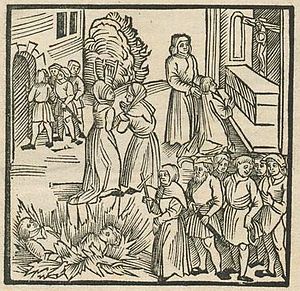Lisbon Massacre
| Lisbon massacre | |
|---|---|

A German woodcut depicting the massacre, one of the few woodcuts that survived the 1755 Lisbon earthquake and the fire at Torre do Tombo
|
|
| Location | Church of São Domingos, Lisbon |
| Date | 19 to 21 April 1506 |
| Deaths | 1900+ |
The Lisbon massacre, alternatively known as the Lisbon pogrom or the 1506 Easter Slaughter was an incident in April, 1506, in Lisbon, Portugal in which a crowd of Catholics, as well as foreign sailors who were anchored in the Tagus, persecuted, tortured, killed, and burnt at the stake hundreds of people who were accused of being Jews and, thus, guilty of deicide and heresy. This incident took place thirty years before the establishment of the Inquisition in Portugal and nine years after the Jews were forced to convert to Roman Catholicism in 1497, during the reign of King Manuel I.
In the years that followed the banishment of the Jews from Castile and Aragon in 1492 by the Catholic Monarchs, about 93,000 Jews took refuge in neighbouring Portugal. King Manuel I was by far more tolerant toward the Jewish community but, under pressure from Spain, made their conversion to Roman Catholicism compulsory in 1497.
The massacre began, as it is reported, in the São Domingos de Lisboa Convent on Sunday, 19 April 1506. The faithful were praying for the end of the drought and plague that swept the country when someone swore they had seen the illuminated face of Christ on the altar — a phenomenon that could only be explained by the Catholics present as a message from the Messiah, a miracle.
A New Christian, one of the converted Jews, thought otherwise, and voiced his opinion that it had been only the reflection of a candle on the crucifix. The men gathered for Mass, hearing this, grabbed the man by his hair and brought him outside the church where he was beaten to death by the crowd and his body was burnt in Rossio (one of the main squares of central Lisbon).
From that point the New Christians, who were already not trusted by the population, became the scapegoats for the drought, famine and plague. Dominican friars promised absolution for sins committed over the previous 100 days to those who killed the "heretics", and a crowd of more than 500 people (many of them sailors from Holland, Zeeland and Germany) gathered and killed all the New Christians they could find on the streets, burning their bodies by the Tagus or in Rossio. That Sunday, more than 500 people were violently sent to their deaths.
...
Wikipedia
